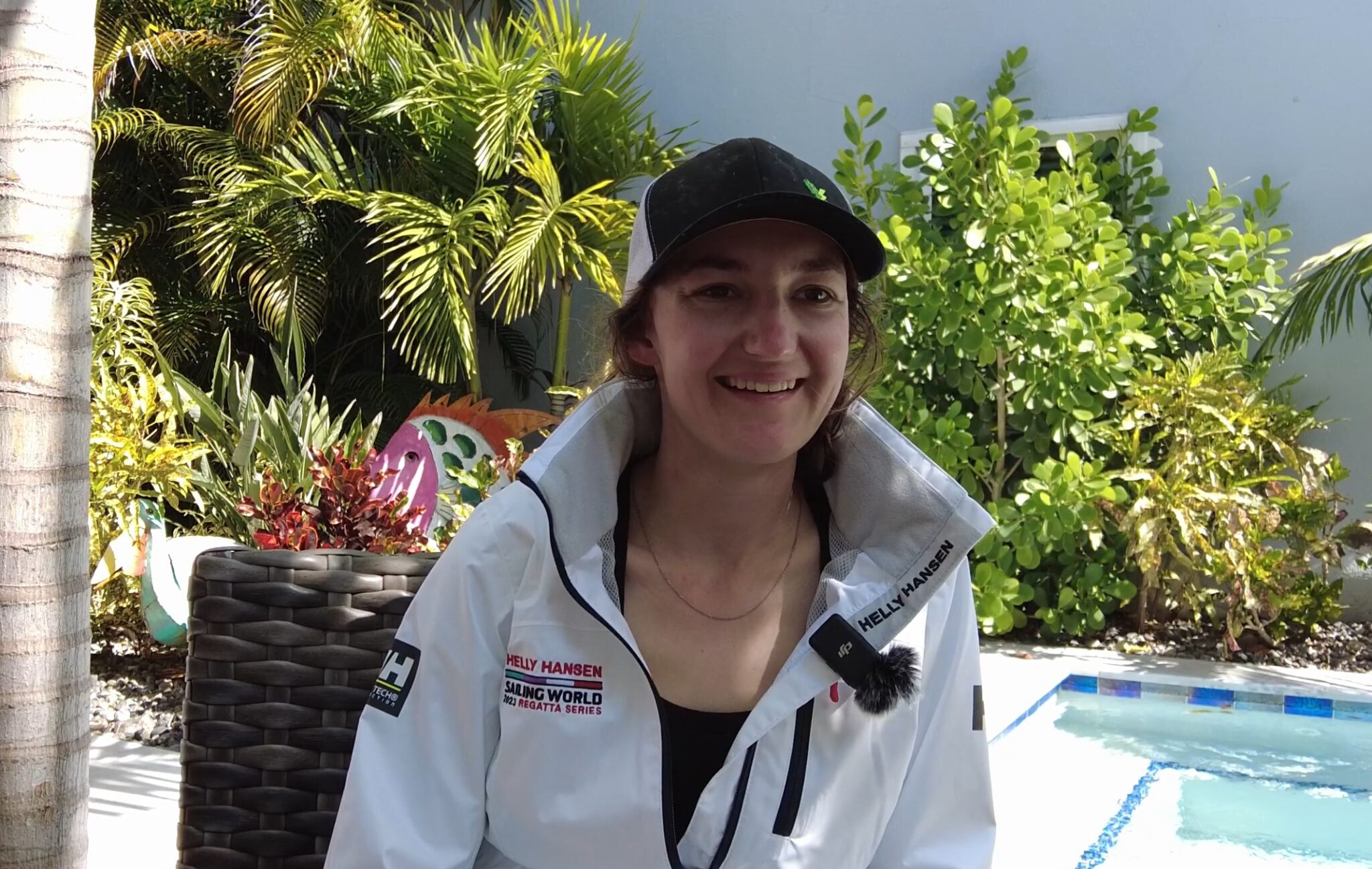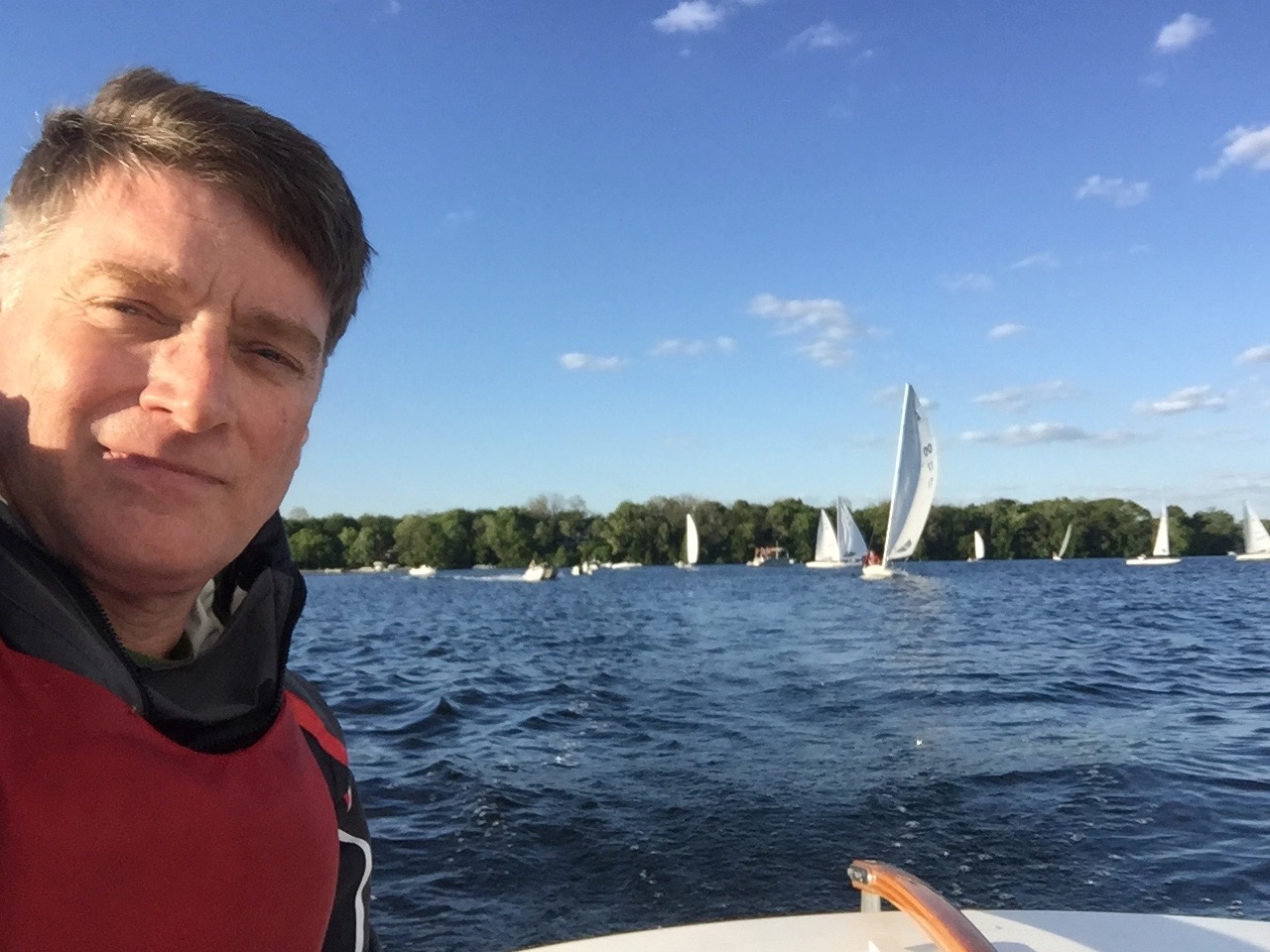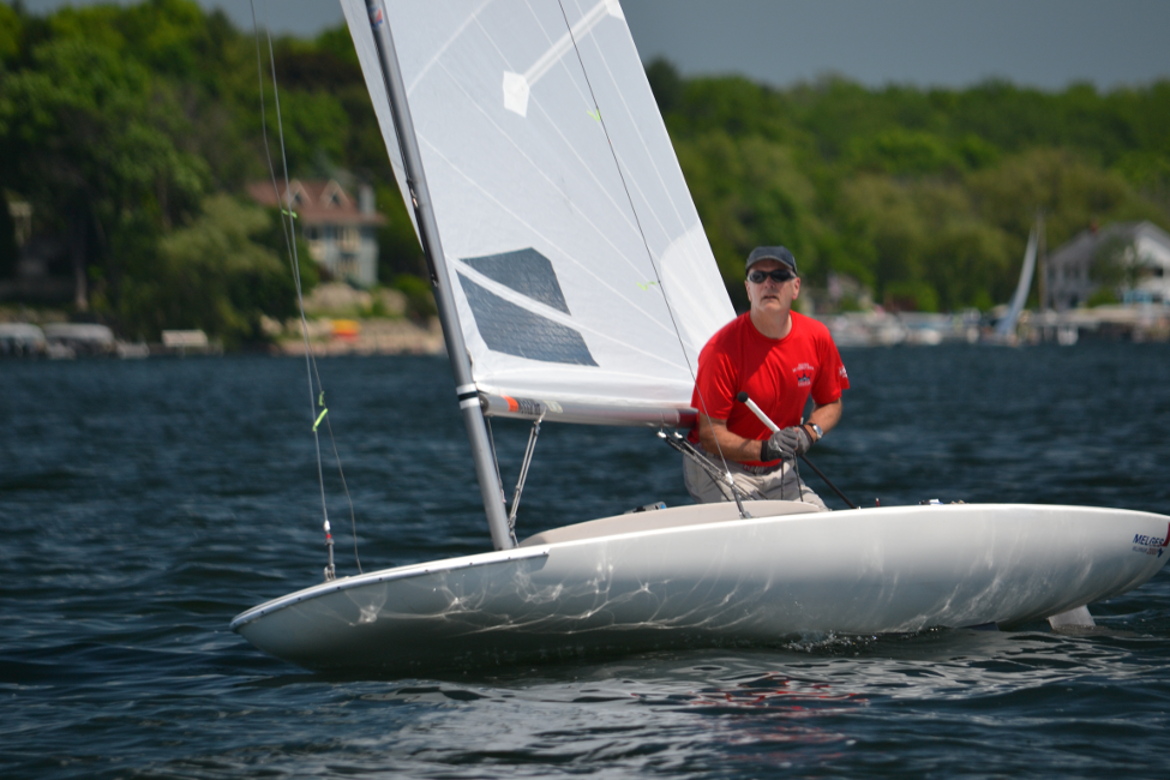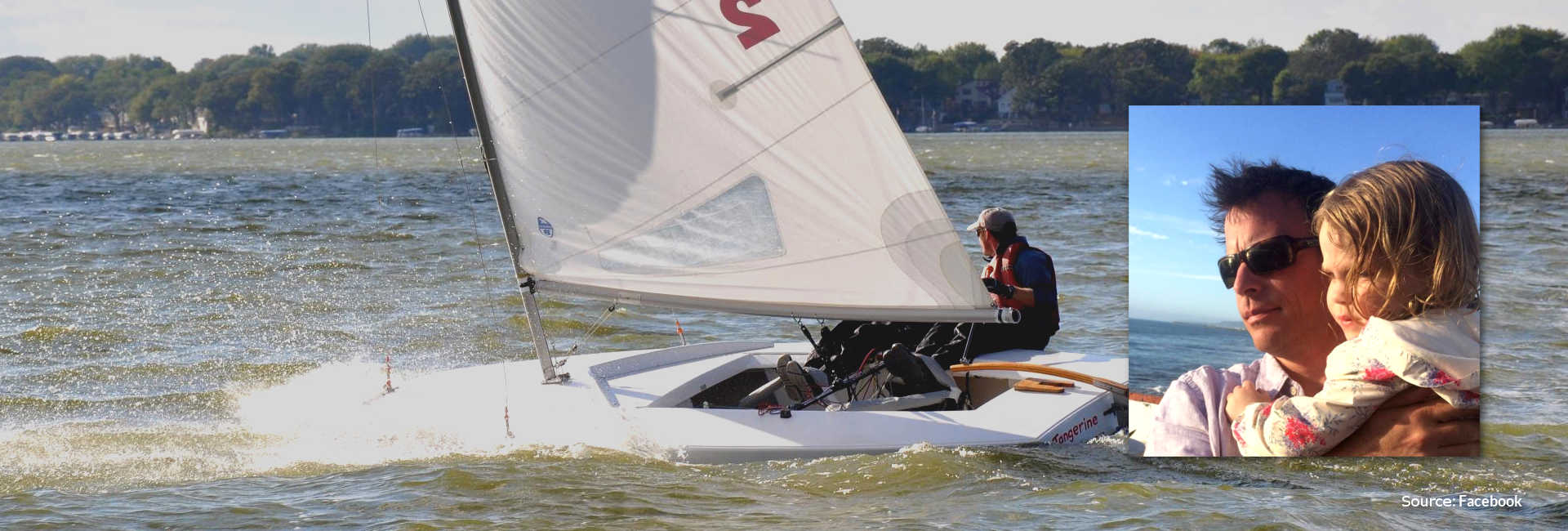We sat down with Collegiate Sailor Abby Brown after she crewed to a 2nd place finish with skipper Mike Schroff on the Melges 15 – USA242. She shared how she got into the sport growing up in Canada, how she started loving the sport after a slow start and also shared some top tips for coaching and for sailing fast from the front of the boat.
We had a lot of fun talking with and learning from this young sailor and will keep an eye on her progress. We filmed this after their 2nd place finish at the Helly Hansen Sailing World Regatta in St. Petersburg, FL.
Related: Watch the interview with both Mike Schroff & Abby Brown.
SZ: Hi Abby! It’s such a pleasure to sit down with you and talk. Tell us a little about who you are and your sailing experience.
Learning to Love Sailing
Abby: I’m Abby Brown. I grew up sailing on the west coast of Canada. So all around Vancouver Island, a little bit Vancouver. My parents both sailed, so I was kind of forced into it and I hated it at first. My parents would drop me off at Learn to Sail in the summer and I was not a fan. But I just kept at it and I got better. I started on a race team and I am very competitive, so the fact that I was able to turn something that my family did all the time into something that I could compete in was awesome.
SZ: That’s a common story. I grew up next to a family where one of the children, one of the people, went on to the Rio Olympics, but I remember the days when it was “I have to practice again! Nobody else is having to practice!” Was there a transitional moment where you went from “Boy. This is a drag” to “Oh wow!” and what were the things that you experienced that caused you to flip?
Abby: A lot of it was who I was sailing with. So my first couple of coaches were just summer sailing coaches and it felt a lot like they were doing it for a job as opposed to doing it because I loved it. I could see that they loved it, but they loved sailing, they didn’t necessarily love coaching. Then I…at that same club, we had some turnover and I got some awesome coaches and they really they made it fun. They made you want to show up. I still didn’t necessarily want to go out on the water, but I wanted to be there. That was the first step. Just like getting me to the yacht club. Then they started bringing me out on their keel boats. One of them had a J24 and then later on bought an Olson 30. So we did a lot of keel boat sailing on the weekends and that kind of thing. They really just got me into it and showed me the fun side of it. As opposed to…my parents dropped me off here and now I’m stuck here for the day, kind of thing. That really hooked me. Then I went on to a race team in Nanaimo. Our coach there had a lot of faith. It was a small club. We had maybe three or four 420s going at a time. So it was a very tight-knit community. I still keep in contact with all those guys. Some of them are off doing 49er campaigns now and one of them’s down in Antigua. We all did amazing. I think it’s because we were such a small team and we all bonded really closely and again we had a coach that really drove us. Then I moved out to Victoria and same kind of thing. I had a great coach, Steve McBride, he’s done everything, and again, he just had so much faith. He is coaching at Royal Victoria Yacht Club. He’s done a lot. He brought our paralympic team down to Rio. He’s an awesome coach. Same kind of thing. He just had the faith and he showed me how it can be fun and where I could go with it. It just kind of opened a bunch of doors from there. Now I’m out in Ontario. I’m going to University and I’m coaching the very Junior race teams and getting them at that same kind of moment. I want them to be excited to go sailing. I don’t want them to feel like it’s work yet. Eventually, if they get good, it will feel like work. I’ve definitely had those moments too, but just making it fun first and then they want to do it. Even if it there aren’t fun moments, they know that the fun is coming. That was a big part of it.
Sailing Competitively
SZ: So, do you like to drive? Do you like to be in the front?
Abby: I have spent a lot more time in the front, so I’m definitely more confident not driving. That being said, I have a match racing regatta in Vancouver starting on Thursday and I’m driving for that one. So, I can do it, but I definitely like being in the front. I like being able to trim sails and have different roles. I find that, and there’s nothing against this, but if you’re a good driver, you often end up driving boats. If you’re a good crew, you kind of get to move around a lot more and there’s a lot more opportunities. Because a lot of the time, the driver is the owner and I don’t own a boat. I probably won’t for a very long time. I just found that it opened a lot more doors to be a crew, but I do love driving the boats,
SZ: The jib and the chute are incredibly important. They make a huge difference and so really you’re in control a lot up front. So can you tell us a little bit about how you manage that? How do you think about setting the jib and how do you think about setting the Spinnaker? What are some of the things… We had a experience in the last weekend where you helped my crew think through some things with setting the chute downwind. Can you kind of walk through your thoughts about how you lead the front?
Abby: A lot of it for me is about the feel. I’ve been sailing for a while, so I know what it’s supposed to feel like and I just play with it to get it where it’s supposed to be. It does take a while for you to get to figure out what it feels like. So, to get there I would say go out with someone that already knows what it’s supposed to feel like. Get them to set it up and then you get to feel it. So that’s the first kind of step for my kids. I will rig out their boat. I will tune up their boat. They go out and they know what it feels like to feel how it’s supposed to feel. Then I tune it up wrong so they know what it feels like when it’s wrong. They kind of get that feel in the boat of this is how it should feel in this wind and this is how it shouldn’t feel. So it’s a lot of feeling and within that. …and then I make them do it. I don’t tell them what to do I’m just like “Okay. Like go play with your vang today. We are cleating the main sheet. Sail with your vang. Just getting them to feel the boat and feel what feels right…what doesn’t feel right. Like “This feels fast going upwind, but really slow going downwind” and that kind of thing. So it’s a lot of…I want them to be able to close their eyes and just feel how the boat is moving. Or look at the sail and see how the sail looks and be like “This isn’t right. I need to change it.” Or “This is right. It feels good.”
SZ: If you were, because a lot of it is probably just feel, it’s intuition at this point, but if you had to force yourself to try to put words around what you’re feeling…how would you describe right versus wrong?
Abby: So I would feel…so, on the upwinds, a lot of it, and we experienced this on Friday, was… We were sailing upwind and we didn’t have power through the waves. My Skipper was driving through the waves amazing but we just didn’t have the power to get through them all the way. You can kind of see it on your boat and if you have a Speed Puck (Velocitek) or of a Vakaros Atlas 2, anything that’s telling you how your speed is going, you can see it. It’s going to drop every wave or every puff or every lull. It’s not going to stay consistent. So that’s a good way if you need…if you don’t know the feel yet, you can kind of look at the speed and be “Okay. We’re going slow. We’re going slower.” Or look around and be like “We’re going slower than all the other boats.” So you can see it that way and it’s good. So I guess, seeing it first and then feeling it. But yeah, it’s hard to explain. Once you look around and you see that you’re going slower then you know that something probably isn’t right. Or if you see that you can’t…if you hit a wave and you can’t sail through it, that’s a really good tell. On the downwinds, if your Skipper is having to head up almost upwind to get you guys up on the step or that kind of thing. So there are tells. A lot of it is just looking around at the other boats. If you can go out and practice, practice with more than one boat. You can set up the two boats completely differently and see which one’s doing better. It’s a lot of just trial and error. “This worked” and then you write it down. “In this wind, in this condition, this is what felt really good” Then you write down what doesn’t work. “In this wind, in this condition, having the vang off was horrible” or that kind of thing. So, yeah. Just being able to go out with other boats and play around with it that way is a really good way. Then once you can see that you’re going fast, just close your eyes and feel what the boat feels like. That will help you get the feel. So you can, instead of having to look at other boats, you know “I am going as fast as I can at this point” or “There’s something wrong with that”.
Get to Know The Boat You’re On
SZ: That’s really cool. Also knowing what your options are, right? You have a set of things that you know. “Okay, I can try moving the jib cars or I could ease the sheet. I could pull in the sheet. I could adjust the vang. So knowing what are the tools that I have available to me to shape the sail…plus body weight. “Am I hiking enough?” Maybe we’re not driving through because I’m not putting enough work into it. So knowing your options sounds like it’s also really important.
Abby: Yes. Exactly. A lot of that comes to when you rig up the boat. If I step on a new boat, like this weekend I was on a Melges 15 for the first time. I wanted to rig the boat. I had no idea how to rig the boat. So I did need help, but I wanted to rig the boat as much by myself as possible because then I knew every single line that was on the boat. I knew where the main sheet was. I knew if the bridle was adjustable. I knew that there was a boom vang and how the outhaul worked and how the cunningham worked. On our jib, there’s a leech line and a foot line. So I knew that those two were options. I knew in this boat there’s no windward jib because…you can move the car positions. Whereas, on a 29er they have…you move the sheet up and down the foot of the sail. Then you can also move the sides in and out. Or on the 420, you don’t have any of that. You just have your leeward sheet and your windward sheet. So every boat has different options. So it’s really good to know what options are available in your boat.
Chute Adjustments in Varying Pressure
SZ: A great point. Get to know the boat that you’re sailing in. It may be different from the boats you’re used to. So talk about the chute. You were sharing some great insights with my crew. We were going through some moderate breeze with changes in pressure. You were helping him to understand how to adjust the chute for different winds. Can you kind of walk through the challenge, the problem, that he presented to you and then what you suggested?
Abby: Yeah. So how I remember it is, he was having trouble going through the transition zones. The kite (chute) started to collapse and he would have to bring it back. But when the kite collapses, it takes an extra second to fill. So there was that…how do I anticipate what’s going to happen so my kite doesn’t end up collapsing. So it’s a lot of being proactive instead of reactive. …and a lot of it comes with experience. If you’re sailing on an asymmetrical kite boat, if you can get yourself out on a 29er, it is a great option. Because, if you do something wrong, typically speaking, you end up in the water. Which is a great learning tool. You’re like…”Oh yeah. That was wrong. Now my boat’s flipped over.” But it really comes down to where your apparent wind is. It’s great to know where your true wind is and where the puffs are coming from and where the lulls are coming from. But on the downwinds in these boats you’re really trimming it to your apparent wind as the wind conditions change. Or as you drive and as your speed accelerates that is changing constantly. So when you sail into a lull, it’s going to move back. And as you hit a puff, it’s going to come forward. When you get on the step (planing), it’s going to go even more forward. So a lot of it comes down to Skipper-Crew communication. If the skipper has the ability to be looking out of the boat and calling what’s about to hit, that is great. But a lot of the time, you can actually feel it in the kite before it’s going to hit, just because the kite is so thin, it’s so sensitive that you can be like…”Oh. There’s a puff coming. I can feel the pressure building, so I’m going to trim in a bit assuming that my apparent wind is going to come forward.” I’m not talking about strapping (over tightening) the kite. Do not strap the kite, because that is slow too, but just that little bit in more. You just to try and get…”Okay. I think this is where it needs to be.” Then once the pressure fills, re-adjust and be…”Is this right? Can I ease it all or should I pull in even more?” Every boat’s a little bit different, but just kind of figuring out what is going to happen to your apparent wind in this change. Are you sailing into a lull? Is it going to go back? Should I ease in it, like not so much that it collapses, but ease in anticipation. So that as we sail through the lull, we can keep that pressure in the kite and it doesn’t end up strapped. As you come into a puff, can I sheet in, not necessarily early, but as the puff is hitting us. Then that will prevent the curl from becoming too much or the kite from collapsing completely. I’m still not perfect at it. There were definitely a couple times this weekend where my kite was over strapped or it was collapsed. I got busy looking out of the boat and I wasn’t watching the kite and my apparent wind shifted and I didn’t notice. So, no one is perfect at it, but it’s the big thing. The one that your crew, that really clicked is, I was like “You’re trimmed to the apparent wind. Figure out what your apparent wind is going to do and see if you can be proactive in that reaction.”
Don’t Forget the Jib
SZ: Well I always say that sailing…the one who wins in sailing is the one who makes the fewest mistakes. You know? It’s one of those things nobody is perfect. “Exactly. Yeah.” No one knows exactly what’s going to happen with the wind. So, certainly we’re all making mistakes out there. The other thing I would say is that the things that you’ve mentioned also matter for the driver. Easing your main. Tightening your main. “Yes exactly” How you have your weight situated on the boat. If you know pressure is coming, being ready to move your weight so that you’re, hopefully your boat never changes, right, because you drive all that into forward motion. So anticipating, that’s a great, a great point to me.
Abby: And a lot of it too on these boats, and really any boat where you don’t take your jib down (while flying the chute), a lot of people forget about their jib on the downwinds. But if your jib is up, if it’s not furled, if it’s not dropped on the deck, it is another sail. It will affect the flow that goes around your sails. So, on the Melges 15, there’s a window in the main and that is the perfect spot to look and just make sure that the slot between the Spinnaker and the jib and the jib and the main are all the same. It’s really easy on these boats to notice, because if your main is too far out, it will be back-winded instantly. If your jib is too far out, your kite isn’t going to work properly and you can feel it in your kite so quickly. If you have never held a kite before and if you have a kite in your hands and the jib is too far out, I guarantee you’ll notice almost immediately because it just doesn’t feel right. If you pull that jib in a little bit more and get that slot opened up, all of a sudden you’re so much faster. So, there are videos of us from this weekend and every once in a while we get up on the step and I’m like “Hmm. Something doesn’t quite feel right.” I ended up…I was holding the kite sheet in one hand and I had my jib sheet in the other. I was just “Do I need to ease it? Do I need to pull it in?” I was kind of playing with that too. Because, as your apparent wind changes, your jib trim also changes. It’s one more thing to think about. When you’re starting out, don’t worry about it. Just find a kind of middle spot and just cleat it (the jib sheet downwind). But as you get better and you’re like “Okay. I have my kite trim down pat, but we still aren’t going as fast”, start looking at that slot and figure that one out too. That’s a big part of it.
SZ: Well, those are some great ideas Abby! Thank you so much for sitting down with SailZing.com and we’ll hope to interview you again in the future.
Abby: Of course. I would love to… Thank you so much.
Related Content
Mike Schroff and Abby Brown Interview – St Petersburg Helly Hansen Sailing World Regatta 2023
Terms Used
- Strapping – trimming the spinnaker in too tightly.
- Chute / Kite – Spinnaker
- On the Step – getting up on a “plane” where the boat lifts up on the water due to speed.





